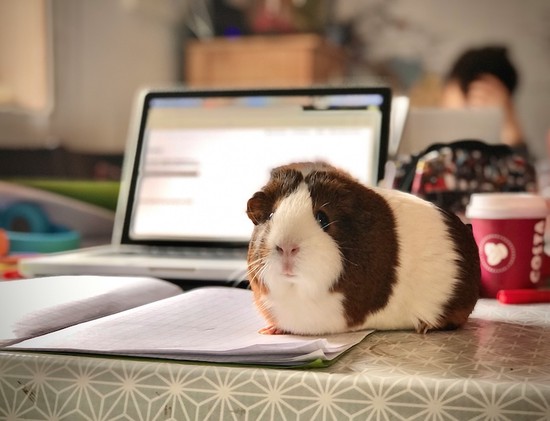While writing an article about my writing process, I found myself procrastinating.
So, I started writing an article about why I procrastinate, and whether it can be a good thing.
But then I found myself procrastinating further. I went down a rabbit hole researching techniques for overcoming procrastination, which wasn’t part of the scope.
The result? This article. And how on earth did I get it written? By trying out the tips below, which are often suggested to writers who simply want to get stuff done.
1. Work next to someone
For when you need an accountability partner.

Photo by Dan Barrett on Unsplash
Whether in-person or virtually, working side by side with someone can help boost productivity. After all, you don’t want that other person to see you slacking off.
This has been my go-to for many years. In university it was study groups and pep talks via MSN Messenger. Today, it’s sharing word count updates via Zoom, or quietly typing away next to a friend.
I wrote some of this article while hanging out on the sofa in my partner’s study, while he ignored me and got on with his work. I did have to put up with his choice of music, though.
2. Get away from your desk
For when you need to get your thoughts flowing again.
Get outside. Get some exercise, if you are able. Or just take a coffee break.
I’ve always found that going for a run helps to clear any mental fog, and as a bonus I come back feeling great!
Simply stepping away from the desk and looking out the window or stretching also helps to clear the mind.
When I got stuck writing this article, I went to the rug and did some stretches. After a few minutes I felt impatient to get back to my desk and approach the problem with a fresh perspective.
3. Switch to dictation mode
For when you’re feeling stuck, mentally or physically.

Photo by Sebastian Pandelache on Unsplash
Assuming you aren’t already doing so, dictating rather than typing can free up your flow of thoughts. It can also combine with tip #2 to get you up and away from your desk.
I hadn’t tried this before, and I don’t have specialist speech-to-text software. So I used my MacBook’s in-built dictation settings to work on part of this article inside Medium.com’s editor, and in both Scrivener and Microsoft Word.
It worked great in Word – punctuation was added automatically and mostly correctly, according to my pauses and emphasis. Most of the words on the page were correct. It was pretty good at distinguishing between spoken commands and text.
In Scrivener and in Medium’s editor, it’s necessary to say every punctuation mark out loud (full stop). But it’s still pretty smooth and responsive.
I found dictation great for getting my words down quickly. I can imagine that sometimes, speaking the punctuation out loud might help to slow things down.
Unlike with typing, I couldn’t easily edit my way through the first draft. This helped me stay focused on the creative process.
The downside? I come across well in writing, but I’m an inarticulate mess when speaking. So I had to do more editing than usual. I also felt awkward speaking my thoughts out loud, even with no one around to hear.
4. Switch your working location
For when your usual surroundings are just too distracting.
This is such a common tip, but it works. Head to a place that isn’t your usual office, where you can get some work done. Don’t connect to wi-fi if you don’t need it. Now your usual distractions are gone, and all you can do is write.
This absolutely works for me. It also helps mentally to have a change of scenery from time to time.
I started my last article in a coffee shop and finished it in a library.
5. Set yourself a deadline
For when you need to work fast.

Photo by Tungsten Rising on Unsplash
This article didn’t have a deadline. So I tried to imagine it was for a client, who needed it within a couple of hours.
Just to pile on the pressure, at one point I also challenged myself to get 100 words down in the next 10 minutes. If I reached that goal, I’d get a piece of the emergency chocolate in my desk drawer.
The word target helped me move quickly, and I was less tempted to edit as I typed. I managed 177 words.
As for the larger deadline, it worked. But I suspect the particular novelty and structure of this article, combined with all the other anti-procrastination tips I was trying out, really helped with the overall flow.
I’m not always great at self-discipline, but I am good at structuring my day. I’m lucky to have a lot of freedom in how and when I work, so each day I plan out what I want to achieve in the morning, afternoon and evening.
So in a sense, I already use this tip daily. But I suspect that if I’m really stuck, adding an imaginary deadline probably isn’t going to work on its own.
So, did I write this article without procrastinating?
Not exactly.
I wrote the article pretty quickly overall, but at one point I did fall down another rabbit hole.
I had initially drawn up a list of 10 tips. While testing them out, I realised that some were strategies I already include in my writing process, rather than stuff I’d use to aid my concentration or work through roadblocks.
The good news? The initial article I’d been writing, before getting waylaid twice, was about my writing process. So it’s all material I can incorporate, thanks to my waste-free editing methods!
Wait a minute, waste-free editing? That would make a great article…
